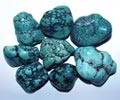
The turquoise stone - It is a symbol of happy love and a happy family life.
In astrology, turquoise is subject to Jupiter. For the ancient astrologers the turquoise stone was not part of the zodiac. However, it is recommended for people born under the sign of Sagittarius. Almost universally, turquoise is the stone of the month of December.
Turquoise was the main stone of the East, the sacred stone of Tibet, the stone of the Egyptian pharaohs, as well as the celestial stone of American Indians.
Many of the stones lose their power unfathomable, but the turquoise is able to maintain its mystical properties, changing color, becoming clear, from blue to white. Apparently, its whimsical nature has inspired many legends and myths, because in a way illustrates the changes.
It was believed that turquoise reflected different states of health. It becomes clear if its owner is sick, it turns white after his death, and can return the color if the owner is a healthy heir.
Egyptian goddess Hathor was called the "Queen of Turquoise", in the same stone it is carved scarab, the sacred symbol of the god Ra. Aristotle wrote that turquoise protected from death, it was used in the treatment of scorpion bite.
In Tibet, no stone was considered a deity except turquoise. A famous Tibetan family even had its name as "a turquoise roof," believing that it would bring luck.
Native Americans wore turquoise beads, in the belief that turquoise saved from fear and deadly bite of snakes. The Navajo shepherds wore pearls to protect themselves from storms. They threw a turquoise stone into the water to plead the rain god and the god of the winds. The most important thing for the Indians was the effect of turquoise in the hunt. Turquoise was also a prize in various competitions and a means of exchange in trade. It is used in many religious rituals.
In China, it was believed that turquoise might give great strength to those who watched it.
In the rites of magic, meditation on the turquoise stone in a full moon night could improve the health and bring victory in battle. Many ancient writers attributed to turquoise the ability to treat epilepsy, intestinal disease, ulcers, cancer. The Russian soldiers wore turquoise as a protection in battle. It was particularly appreciated by riders. The Romans connected turquoise with the goddess of love Venus wearing it on Friday - the day dedicated to Venus, the day of love. In Russia and in Germany it was believed that the wedding ring of turquoise would strengthen marriage and the reconciliation of the spouses in the event of family quarrels. Among the main features of the stone is the power to reconcile the conflicting parties, to stop a fight and maintain the peace. But it is not recommended to wear if you are angry.








